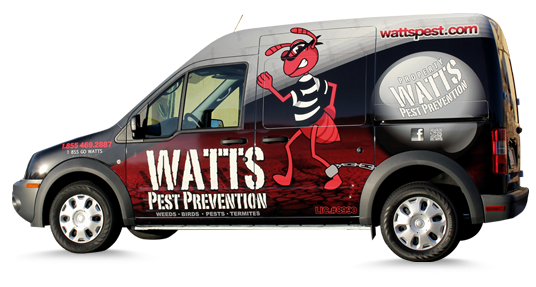WASP REMOVAL SERVICES PHOENIX ARIZONA
The various Wasp species of the order Hymenoptera display different habits. Some are social and live in colonies, while others are solitary. Hornets are of the family Vespidae, closely related to (and resembling) Yellow-Jackets. There are about 20 Hornet species. Most live in tropical Asia but are also found in North America, where the European Hornet was introduced by humans. Hornets are often considered Pests, particularly when they nest near humans, because they will defend a nest aggressively if they feel it is threatened.
Your friends at WATTS Pest Prevention want to provide you with information to distinguish the various types of Hornets / Wasps you might be experiencing a problem with:
- Bald-faced Hornets (name derived from the large white patches on their faces)
- European Hornets (much larger than other Wasps)
- Cicada Killer Wasp (most often mistaken for a Hornet)
- Mud Daubers (Wasp named for constructing nests of mud)
- Horntail Wasps (birthed from wood where female has deposited her eggs)
- Cockroach Egg Parasites (after Wasp lays eggs inside cockroach, larvae feed on and kill cockroach embryos – adult Wasps emerge and may be seen inside properties, especially those infested with cockroaches)
Some of the most impressive insects in the Sonoran Desert are the enormous Tarantula Hawks (Pepsis). These 1 to 1¾ inch Wasps sport brilliant gun metal, blue-black bodies carried on fiery orange wings. The desert contains more than a dozen species, some of which have jet-black wings instead of orange wings.
Velvet Ants (Dasymutilla) are among the more colorful of all organisms in the desert. Females of these large ant-like Wasps can be seen scurrying over sandy or bare soil surfaces during warmer seasons of the year. More than three dozen species live in the Sonoran Desert of Arizona. They range in size from tiny species to huge 1 inch giants. Most are clothed in red, orange, yellow, or silver coats of hair-like setae (bristles) and look like moving fuzzy cotton balls. Particularly large Velvet Ants include the black and red D. klugii and Satan’s Velvet Ant, which is black with a yellowish-white furry abdomen. The glorious Velvet Ant (D. gloriosa) is a long-haired, totally white velvet ant that looks like a creosote bush seed on legs.
Why be concerned about Wasp Control?
It is important to distinguish between the various Wasps and Hornets because their potential as problems and their control differ. For instance:
The habit of some Wasps to nest in many locations around a yard has greatly increased the incidence of stings associated with Wasps. Wasps are very aggressive from August to October—during these months, the preferred food of Wasps shift from insects. During these months, Wasps can be found in food and garbage. Unintentional contact happens which could lead to a Wasp attack.
Bald-faced Hornets are aggressive and will attack anyone or anything that invades their space. They have smooth stingers, so they can sting repeatedly. Their stings also carry venom that makes the stings hurt, itch, or swell for about 24 hours. Humans are at the same risk of allergic reactions from a Bald-Faced Hornet sting as with other Hornet stings.
European Hornets can do a great deal of damage to trees and shrubs, because they strip the bark to get to the sap. They also use the bark fiber to build their nests. They have smooth stingers, so they can sting repeatedly. Their stings also carry venom that makes the stings hurt, itch, or swell for about 24 hours. A European Hornet sting has the same risk of allergic reaction as with other Wasp stings.
Identifying Hornet / Wasp Infestations:
Unfortunately, the first sign of Hornets / Wasps may be when you, a family member, or pet is stung.
Following is information about two types of Hornets:
- Bald-Faced Hornet – large nests hanging from trees, bushes, vegetation, and occasionally from buildings made from paper strips and loose bark.
- European Hornets – nests are typically built in hollow trees but often found in barns, sheds, attics, and hollow areas of house walls made of decaying wood fiber around the nest as protection.
The many types of Wasps fall into two categories: Solitary or Social.
- Social Wasps – operate as part of a colony that can number several thousand. They build and live in the large, commonly found Wasps nests.
- Solitary Wasps – generally more diversified compared to social Wasps. Their nests can be found almost everywhere in the walls, in the trees, or even in the ground. Solitary wasps build a nest made of mud where they deposit an egg. They do not make a hole in the wood but create a small nest for a single egg and leave them until they are ready to hatch. Just like their eggs, the behavior of solitary Wasps is also individualistic. They do not go out in groups but instead roam around alone.
In the case of all suspected Hornet / Wasp infestations, please allow us to investigate and handle the issue for you! Your WATTS Pest Prevention technicians are trained on both Hornet / Wasp basics and the latest control techniques.
Preventing Hornet / Wasp Recurrence:
Your WATTS Pest Prevention technician will be involved closely with you to educate you regarding Hornet / Wasp Control, ensuring you are aware of what you must do to assist us with a successful plan. This will include tips that only you, as the property owner, can ensure are completed. Some things your WATTS Pest Prevention technician will do as part of our Integrated Pest Management (IPM) plan.
Treating Hornet / Wasp Infestations:
Hornet / Wasp Control must be thorough and your cooperation enlisted in removing any Hornet / Wasp harborage. The methodology and technology vary according to the type of Hornets / Wasps involved. Environmentally sound Hornet / Wasp management incorporates numerous tools to achieve success. Your WATTS Pest Prevention technician is licensed by the State of Arizona and has been specially trained in the safe use of all products necessary to take care of your Hornet / Wasp Control problem. This combination of approaches is generally known as Integrated Pest Management (IPM) and is the approach used by WATTS Pest Prevention.
WATTS Pest Prevention looks forward to serving you and servicing your property!
Refer to the Pest Control page for D.I.Y. Prevention Tips for Wasp Removal Phoenix Arizona!
IMPORTANT NOTICE: Wasp Control products, if misused, can potentially poison or otherwise harm you, your children, or your pets.
PLEASE NOTE: These Pesticides are only permitted for use by your licensed Wasp Control professional! When their use is deemed necessary, WATTS Pest Prevention technicians follow stringent policies and procedures governing such use.
We utilize an Integrated Pest Management (I.P.M.) approach for Wasp Removal Phoenix Arizona. This comprehensive approach includes:
- INSPECTION – Service specialists conduct a thorough inspection of the property.
- IDENTIFICATION – Pests are identified for appropriate control measures.
- ENVIRONMENTAL MODIFICATION – All possible environmental modification solutions are considered prior to any material application.
- MATERIAL APPLICATION – When a thorough inspection has been performed, a proper identification has been assessed, and all environmental modification options have been made (if applicable), a material application will be performed in a judicious, environmentally responsible manner.
Our service plans include:
- Bi-Monthly service schedules (Residential)
- Weekly – Monthly service schedules (Commercial)
- Termite monitoring
- Exterior only service (inside on request)
- And much more…
Our Wasp Control Exterminators are specialists, thoroughly trained and rigorously tested in the area of Wasp Removal Phoenix Arizona, and will protect your investment from these pests:
- Wasp Control Phoenix Arizona
Ask our customer service representative for more details, including our P.E.S.T. Barricade™ Plan for Residential properties and our P.E.S.T. Blockade™ Plan for Commercial properties! CALL NOW!
My PROMISE means your PROTECTION!
Arizona Cities Served:
Anthem, Apache Junction, Avondale, Buckeye, Cave Creek, Chandler, El Mirage, Fountain Hills, Gilbert, Glendale, Goodyear, Litchfield Park, Mesa, Paradise Valley, Peoria, Phoenix, Queen Creek, Scottsdale, Sun City/Sun City West, Surprise, Tempe, Tolleson, Youngtown



















